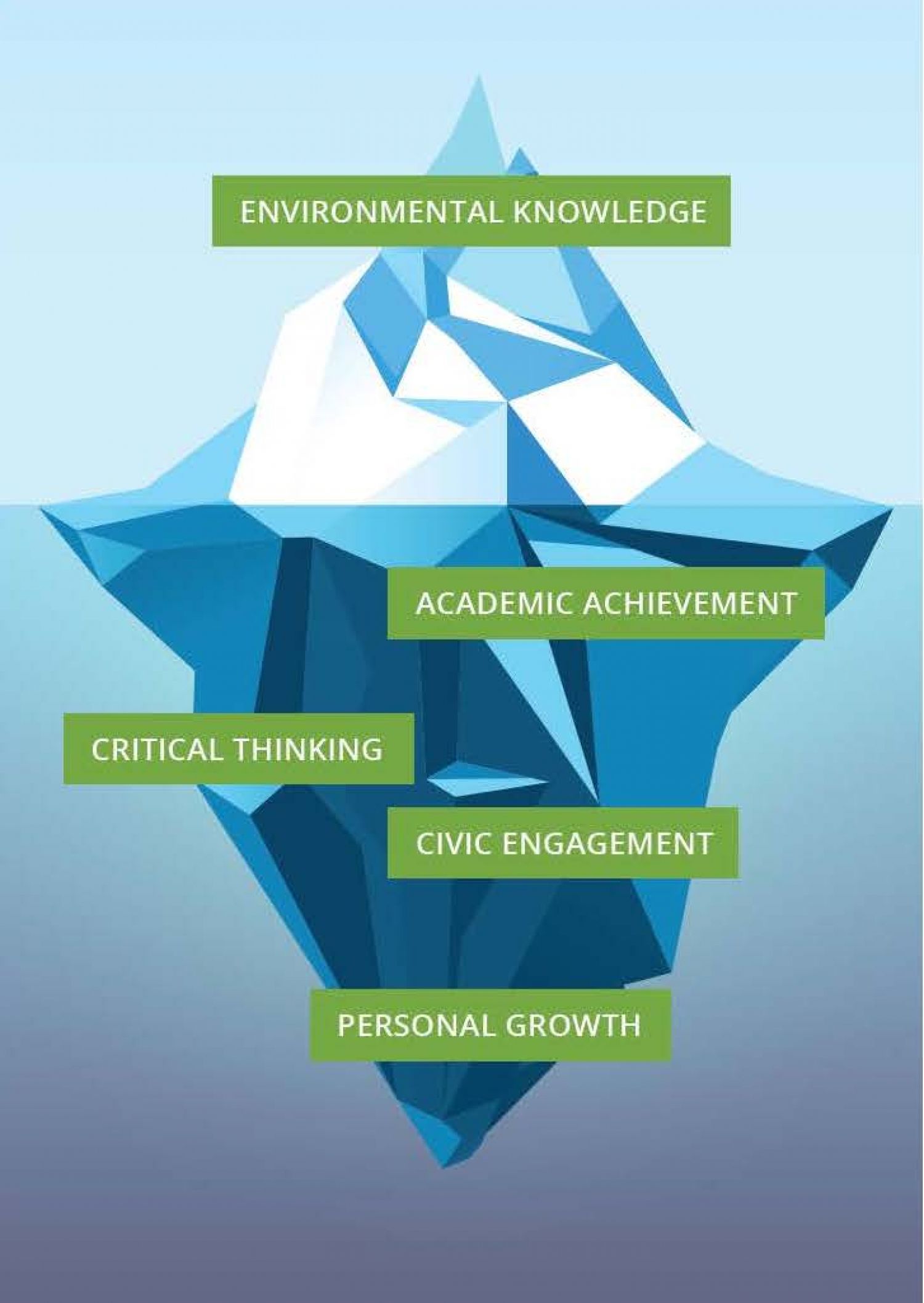Overview
Stanford's analysis suggests EE provides a wide array of benefits for K–12 students—and environmental knowledge is just the tip of the iceberg.
Experts at Stanford University systematically searched the academic literature and analyzed 119 peer-reviewed studies published over a 20-year period that measured the impacts of environmental education for K–12 students. The review found clear evidence that environmental education programs provide a variety of benefits. Not surprisingly, the studies clearly showed that students taking part in environmental education programming gained knowledge about the environment. But learning about the environment is just the tip of the iceberg.
Studies in the review demonstrated that environmental education has led to a number of positive impacts, from improving academic performance, to enhancing critical thinking skills, to developing personal growth and life-building skills including confidence, autonomy, and leadership. In addition, a number of the studies showed that environmental education increased civic engagement and positive environmental behaviors.
Translating the Findings to Benefit the Field of EE
Based on Stanford's review, we have translated these findings into several communication tools for EE professionals to use to substantiate their work and bolster support for programming that benefits K-12 students. These tools include pull quotes, statistics, researcher observations, inspiring stories from across the field substantiated by empirical studies, and more that we hope you will find beneficial for demonstrating the benefits for K-12 students in your work.
Environmental education is about hope and change. There is a mountain of evidence that suggests EE is a powerful way to teach students. Over 100 studies found that it provides transformative learning opportunities that bring tremendous results and engage young people in the world around them in meaningful, collaborative ways. There is no doubt that environmental education is one of the most effective ways to instill a passion for learning among students.
Dr. Nicole Ardoin, Stanford University Graduate School of Education and Woods Institute for the Environment
Key Findings
Stanford Analysis of More than 100 Studies Finds Wide Array of Student Benefits from Environmental Education
Download the Full Executive Summary and Key Findings
This includes a summary of Stanford’s key findings with pull quotes and statistics, compelling stories and observations from researchers across the field, and infographics summarizing the benefits of EE for K-12 students.
Environmental Knowledge is Just the Tip of the Iceberg
Experts at Stanford University systematically searched the academic literature and identified 119 peer-reviewed studies published over a 20-year period that measured the impacts of environmental education for K-12 students. The review found clear evidence that environmental education programs provide a variety of benefits. Not surprisingly, the studies clearly showed that students taking part in environmental education programming gained knowledge about the environment. But the studies also showed that learning about the environment is just the tip of the iceberg.
Studies in the review demonstrated that environmental education has led to a number of positive impacts, from improving academic performance, to enhancing critical thinking skills, to developing personal growth and life-building skills including confidence, autonomy, and leadership. In addition, a number of the studies showed that environmental education increased civic engagement and positive environmental behaviors.
"There is a mountain of evidence that suggests EE is a powerful way to teach students. Over 100 studies found that it provides transformative learning opportunities that bring tremendous results and engage young people in the world around them in meaningful, collaborative ways. There is no doubt that environmental education is one of the most effective ways to instill a passion for learning among students.”
Dr. Nicole Ardoin, Stanford University Graduate School of Education and Woods Institute for the Environment
In studies reviewed, environmental education was shown to improve:
- Knowledge in science, mathematics, reading, writing, and more
- Emotional and social skills, such as self-esteem, character development, team work, and leadership skills
- Environmentally friendly behavior, such as reducing water use, increasing recycling, and participating in community cleanups
- Academic skills (21st Century skills), such as critical thinking, oral communication, analytical skills, problem solving, and higher-order thinking
- Motivation to learn, including enthusiasm for and interest in school
- Civic interest and engagement, including feelings of civic responsibility, feelings of empowerment, and ability to take action
“The peer-reviewed literature from the last decade-plus demonstrates that good environmental education programs can positively influence students’ academic performance, knowledge, skills, confidence, motivation, and behavior.”
Dr. Marc Stern, Virginia Tech University School of Forest Resources and Environmental Conservation
Dozens of peer-reviewed studies found environmental education has a positive academic impact. Because children are often naturally interested in and curious about the environment, environmental education can be an effective tool to teach an array of topics. Studies documented that students gained knowledge in a variety of areas, including the environment, mathematics, chemistry, biology, ecology, and more. In various studies, students and teachers reported that the students enjoyed taking part in environmental education activities, and that the “fun” factor enhanced motivation to learn.
“The most important thing environmental education provides for students is passion and interest in learning. Environmental education creates meaningful learning experiences and engages students in ways that help them grasp and retain new information more effectively than conventional curricula.”
Dr. Doug Knapp, Indiana University Department of Recreation, Park, and Tourism Studies
 Environmental education imparts more than knowledge. It has been shown to develop academic skills, such as critical thinking, decision-making, and synthesizing complex information. Environmental education has helped produce effective problem solvers, lifelong learners, and thoughtful community leaders and participants.
Environmental education imparts more than knowledge. It has been shown to develop academic skills, such as critical thinking, decision-making, and synthesizing complex information. Environmental education has helped produce effective problem solvers, lifelong learners, and thoughtful community leaders and participants.
In fact, a dozen peer-reviewed articles found environmental education had positive civic outcomes, such as instilling a sense of personal responsibility and motivation to address community and environmental issues.1,2,3,4,5,6,7,8,9,10,11,12,
The emotional and social skill-related benefits that a number of studies in the review documented include self-esteem, autonomy, character development, maturity, empowerment, verbal communication, leadership, poise, and the ability to collaborate with others.1,2,3,4,5,6,7
“Environmental education helps students gain much more than knowledge. They gain skills in making a difference and an intrinsic belief that they can. The confidence and empowerment can spill over into other aspects of their lives.”
Dr. Martha Monroe, University of Florida Department of Forest Resources and Conservation

Environmental education helps teachers meet standards across multiple disciplines, and it can be integrated into existing curricula.
A high school in Illinois successfully used environmental education to develop critical 21st Century skills. Students in the program significantly outscored their peers in applying knowledge from science, technology, engineering, and math, and in mastery of critical thinking, environmental literacy, leadership, and communication skills.
“Using the environment as an integrating context, I realized I could increase students’ knowledge, skills, and attitudes/beliefs in STEM subjects while increasing their environmental literacy at the same time.”
Dr. Farah Vallera, Lehigh University Department of Teaching Learning and Technology
Environmental education empowers students to protect the environment. More than 80 percent of the programs studied that seek to inspire students to engage in environmentally friendly behavior were successful; in cases where longer-term outcomes were measured, the impacts were long lasting.
Environmental education is making a big difference in schools across America:
In their comprehensive review of the literature, Stanford researchers found a number of trends that demonstrate environmental education has a very positive impact on learning, motivation, skill-building, and empowerment. And the impact on both students and teachers is impressive. Also noteworthy was the range of environmental education programs being conducted with students. The review suggests that the versatility of environmental education can contribute to a number of different outcomes across a broad spectrum of learning styles. Here are a few highlights:
- A two-year study of high school students in Florida found that, “When controlling for factors like GPA, gender, ethnicity, and socioeconomic status, students who participated in environmental education programs scored significantly higher on measures of critical thinking skills and demonstrated significantly more likeliness to apply those skills in the future.” A 9th grade student explained, “This program has changed the way I feel about school. Now I realize that I can pretty much do what anybody else can do. I have a better view of what I can be in the future”4
One of the teachers explained, “In my 20 years of teaching before using the environment-based approach, I heard, ‘Why are we learning this? When are we going to finish?’ And now when we are out in the field and sorting macro-invertebrates, for example, I have to make them stop after four hours for lunch. And then they say, ‘We don’t want to!’"4
- A year-long study
 of New York-based middle school teachers integrating EE into their traditional learning curriculum noted that, “The hands on aspect [of environmental education] is an equalizer…[for] students with a variety of learning styles and learning abilities. The kids who have trouble learning, and the kids who are super advanced—they’re all having the same discussions.”
of New York-based middle school teachers integrating EE into their traditional learning curriculum noted that, “The hands on aspect [of environmental education] is an equalizer…[for] students with a variety of learning styles and learning abilities. The kids who have trouble learning, and the kids who are super advanced—they’re all having the same discussions.” - An ethnographic study of high schools across the Northeastern U.S. concluded that EE’s participatory methods can increase students’ participation and engagement in class. “EE provides a unique opportunity to help students practice their argument assessment skills, critically reflect on their own views, and encourage an open-minded assessment of new information.”6 - Dr. Erica Blatt, College of Staten Island Department of Education
- A two-year study of a middle school EE program in Ohio reported that teachers are using significantly more innovative teaching practices as a result of participation in the program (more interdisciplinary, inquiry based, hands on, problem based, teaching for depth of understanding, assessing performance based tasks, contextualized learning). Further, teachers report feeling more confident in their abilities to be effective teachers as a result of using EE’s well researched and designed curriculum guidelines.7
- A five-year study of middle schools in Hawaii observed the benefits of integrating EE into their curriculum from both the teachers’ and learners’ perspectives. As one teacher notes, “I think I’m a better teacher because of environmental education. It has kind of completed the ‘whole package.’ The framework unified all my best approaches and it made my instruction much easier.” A second teacher explains, “EE forces me to facilitate rather than dictate…watching 25 young minds start to make their own discoveries…you must sit back and watch the magic work.” That magic is clear from the words of one of her 6th grade students. “[The program] helped me achieve my goals. I can be what I want to be."8

Tools
Communication Tools
Based on Stanford's review, we have translated these findings into several communication tools for EE professionals to use to substantiate their work and bolster support for programming that benefits K-12 students. These tools include pull quotes, statistics, researcher observations, inspiring stories from across the field substantiated by empirical studies, and more that we hope you will find beneficial for demonstrating the benefits for K-12 students in your work.
We have developed 5 communications tools associated with Stanford's student outcomes analysis:
Executive Summary and Key Findings
A summary of Stanford’s key findings with pull quotes and statistics, compelling stories and observations from researchers across the field, and infographics summarizing the benefits of EE for K-12 students.
Student Outcomes Review Process
A summary of Stanford’s methods and key findings for completing a comprehensive review of the literature exploring the benefits of EE for K-12 students.
Selected Study Summaries
A creative annotated bibliography that includes narrative descriptions of selected studies exploring the benefits of EE for K-12 students from Stanford’s review.
Academic Benefits of EE
A collection of compelling stories and pull quotes that focus specifically on academic benefits for formal K-12 teachers.
Messaging guide
Tips for promoting the benefits of EE for K-12 students with K-12 teachers, administrators, and boards; state policymakers; education and conservation funders; and parents.
Process
Stanford's K-12 Literature Review Process
Download a Summary of Stanford's Review Process
A summary of Stanford’s methods and key findings for completing a comprehensive review of the literature exploring the benefits of EE for K-12 students.
Stanford's research team focused on peer-reviewed literature that empirically measured K-12 student outcomes associated with environmental education and was published in English between 1994 and 2013. Over 2,000 publication records were reviewed for consideration of inclusion in the review. The final sample consisted of 119 articles that met criteria for relevancy and basic quality.
The team coded and analyzed the 119 articles to address the following main review questions:
- What K-12 student outcomes are EE researchers measuring and reporting?
- What findings related to K-12 student outcomes are being published?
- What general trends and gaps do we see in EE outcomes research with K-12 students?
Findings from the analysis and team review of the articles were synthesized to provide a summary of the research and to discuss trends in EE research around K-12 student outcomes.
The peer-reviewed literature from the last decade-plus demonstrates that good environmental education programs can positively influence students’ academic performance, knowledge, skills, confidence, motivation, and behavior.
Dr. Marc Stern, Virginia Tech University School of Forest Resources and Environmental Conservation
Research
Research Summaries & Reviewed Studies
Journal Article
A synthesis of Stanford's comprehensive review of the literature exploring the benefits of EE for K-12 students, published in Journal of Environmental Education.
Download the Selected Study Summaries
A creative annotated bibliography that includes narrative descriptions of selected studies exploring the benefits of EE for K-12 students from Stanford’s review.



